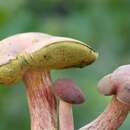en
names in breadcrumbs


Boletus patrioticus, also known as the patriotic bolete is a basidiomycete mushroom, of the genus Boletus in the family Boletaceae. Its name comes from its coloration (red skin, white flesh, blue bruising) resembling the flag of the United States.[1]
It is not recommended to eat, tasting sour and being likely inedible when blue.[1][2]
The cap is 3 to 13 cm in diameter, initially convex in shape, before becoming broadly convex to plane as it ages; The surface is dry with small hair, olive initially and then pinkish to dark red. The thick flesh is pale yellowish to pinkish red and does stain blue when bruised.
The pores are pale yellow when young, becoming olive yellow, bluing when bruised.
From 2.5 to 10 cm long; 1-2 cm thick, dry, solid; rosy red on the upper part and olive on the bottom.
The spore print is olive brown.
Subfusiform, smooth, deep golden brown, 10-13 x 4-5.5 µm[3]
Forms mycorrhiza with hardwoods, especially oak and hickory; fruits in grassy areas, single, scattered, in summer and fall; ranging from North Carolina to Florida (south range) and to Ohio and Texas (west range).[3]
Boletus patrioticus, also known as the patriotic bolete is a basidiomycete mushroom, of the genus Boletus in the family Boletaceae. Its name comes from its coloration (red skin, white flesh, blue bruising) resembling the flag of the United States.
It is not recommended to eat, tasting sour and being likely inedible when blue.